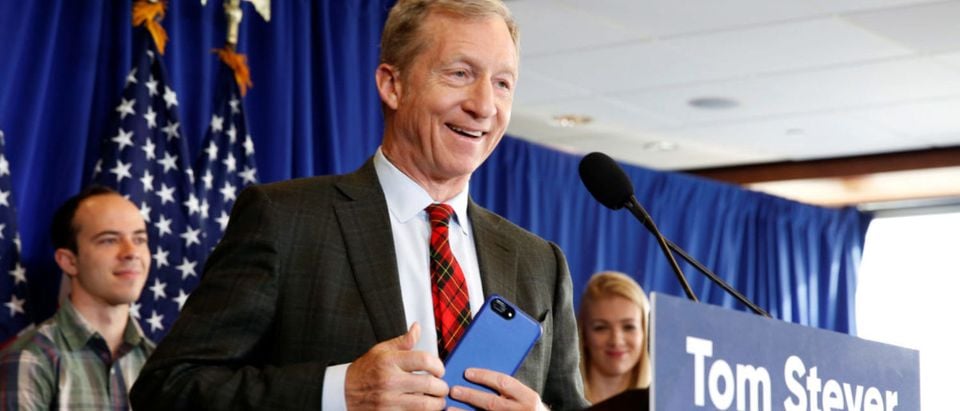Billionaire environmentalist Tom Steyer is backing an initiative that would essentially close down the largest power plant in the United States, despite the fact the plant provides nearly 80 percent of Arizona’s emission-free electricity.
The Palo Verde Nuclear Generating Station, located near Tonopah, Ariz., is the biggest power plant in the country and Arizona’s largest source of clean energy. Commissioned in the 1980s, Palo Verde currently generates enough energy to provide power to 4 million people — over half of Arizona’s entire population. Not only is it a major source of low-carbon energy, Palo Verde also uses 100 percent recycled water and boasts a “Zero Discharge” status – meaning no water from the plant is discharged to oceans, streams or rivers.
Steyer and other environmental activists are pushing state legislation that would ultimately force the plant to close its doors, years before it’s scheduled to retire. Steyer is paying activists to work on the ground in Arizona to get the proposal passed through his NextGen political action committee
HCR 2017, more colloquially known as Clean Energy for a Healthy Arizona, is sweeping legislation that would, if passed, amend Arizona’s constitution to require utilities to obtain 50 percent their electricity from renewable sources such as wind and solar by 2030. The bill would be a monumental ask of Arizona utilities, where the current mandate is only 15 percent by 2025. Critics argue that such a swift transition to wind and solar is unreasonable, given the current build rate for renewables. According to the Palo Verde’s owner, Arizona Public Service Company, such a mandate could shut the plant in as soon as six years.
Should the bill pass and Palo Verde closes its doors, new energy sources would not just be replaced with renewables, but also largely from natural gas. While natural gas is more clean than other fossil fuel sources, such as coal, the bill would make natural gas a replacement for nuclear, a clean source of energy.
If the plant closes, Arizona would be throwing away roughly 700 billion kWh of clean electricity, 5,000 jobs and the largest single tax revenue for locals and the state. If the plant is replaced by natural gas, the result would the equivalent of adding 2.8 million cars to the road.
“[Tom Steyer] wants to replace Palo Verde with natural gas and renewables, although it would mainly be natural gas. Normally serious about addressing climate change, Steyer doesn’t seem to understand that renewables are supposed to replace fossil fuel, especially coal, not other low carbon sources like nuclear or hydro,” wrote James Conca, an earth and environmental scientist, in a Wednesday Forbes article.
Debate over the Palo Verde plant is emblematic of the divide between environmentalists on nuclear energy. Conca argues that the historic animosity toward nuclear energy stems from unwarranted “fear and misunderstanding” of how it actually works. A study by the Brattle Group reveals that closures of nuclear plants results in negative consequences for the environment, with greater amounts of CO2 emissions released into the atmosphere.
Michael Shellenberger, an environmental policy expert and founder of Environmental Progress, explained Steyer’s moves in more harsh terms.
“It’s hard to say which is more outrageous: that billionaire renewable energy investor Tom Steyer is trying to replace Arizona’s largest source of clean energy with a mix of natural gas and solar, or that he’s doing it in the name of climate change. Whatever the case, anyone who is concerned about air pollution, global warming, or simply maintaining cheap and reliable electricity for Arizona should denounce Steyer’s initiative and demand he withdraw it from the ballot,” Shellenberger said in a statement published Wednesday.
Steyer’s campaign, however, doesn’t appear to be receiving significant support from locals in Arizona — if any at all. Recent campaign-finance reports released Tuesday indicate embarrassing news: His campaign did not receive a single penny of financial support from anyone in Arizona or elsewhere in the country. The California mega-donor, through NextGen Climate Action, provided over $957,000 in funding. In fact, NextGen was the campaign’s only donor.
The ballot proposal will be voted on this November.
Follow Jason on Twitter.
All content created by the Daily Caller News Foundation, an independent and nonpartisan newswire service, is available without charge to any legitimate news publisher that can provide a large audience. All republished articles must include our logo, our reporter’s byline and their DCNF affiliation. For any questions about our guidelines or partnering with us, please contact licensing@dailycallernewsfoundation.org.


